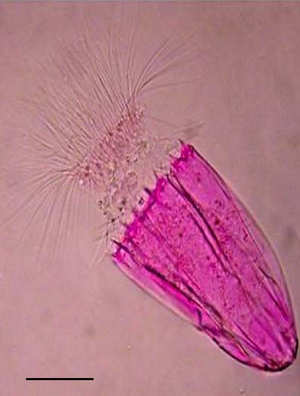Spinoloricus cinziae
| Spinoloricus cinziae | ||||||||||||
|---|---|---|---|---|---|---|---|---|---|---|---|---|

Spinoloricus cinziae |
||||||||||||
| Systematics | ||||||||||||
|
||||||||||||
| Scientific name | ||||||||||||
| Spinoloricus cinziae | ||||||||||||
| Neves , Gambi , Danovaro & Kristensen , 2014 |
Spinoloricus cinziae is a species described in 2014 and was discovered in a salty, oxygen-free basin in the Mediterranean. It is, along with two other representatives of the Loricifera from the genera Rugiloricus and Pliciloricus , the only known multicellular organism that does notdependon oxygen in any phase of its life. S. cinziae uses a so-called hydrogenosome to generate energy.
Etymology and history of research
The additional species " cinziae " honors Cinzia Corinaldesi , an Italian marine biologist and the wife of the co-author Roberto Danovaro who was involved in the first description .
The first specimens of Spinoloricus cinziae were discovered in sediment samples from the L'Atalante basin , an anoxic , hypersaline basin ("deep, hypersaline anoxic basin"; "DHAB"). The sediment samples were collected during research trips in 1998, 2005 and 2008. 2010 was carried out by Danovaro and colleagues under the name “ Spinoloricus nov. sp. ”a first preliminary description. The actual, valid initial description was not made until 2014 by Neves and colleagues.
features
Adult animals reach a maximum body length of only 243 µm. The lorica of the female holotype has a length of about 125 µm and a width of 80 µm. In the holotype, the mouth cone reaches a length of approx. 58 µm.
Neves et al. list the following typical characteristics in their first description: The mouth cone shows eight “ribs” of equal length and the furca, at the base of the mouth cone, is not sclerotized . The mouth of the species has six small, stiletto-like scalids ("stylets") inside . The head (introvert) carries nine rows of scalids, of which the second consists of nine leg-like "spinoscalids", each made up of three segments. The third row consists of seven strong, feather-like scalids, the fourth of a total of 16 spinoscalids, with eight leg-like scalids, each consisting of two segments, alternating with eight also two-part scalids with a feather-like distal end. The eighth row consists of 30 very long, unsegemented scalids with a thickened base. Finally, the ninth row is made up of 30 short, beak-like scalids, each of which alternates with 30 round, plate-shaped scalids. The latter each have a tiny spine protruding posteriorly .
There are eight individual trichoscalids on the neck, which alternate with seven double trichoscalids. This feature occurs in all representatives of the Nanaloricidae; however, in Spinoloricus cinziae the double trichoscalids are separated. The Lorica is made up of six individual panels with honeycomb sculptures. The six individual plates of the Lorica are provided with large spines anteriorly , each of which has a small spike at the corners of the plates. At the posterior end of the lorica there are seven dimples ("flosculi") and two furrows that are flanked by the flosculi.
distribution and habitat
Spinoloricus cinziae is so far only known from the sediments of the L'Atalante basin in the central Mediterranean, where the species appears as a representative of the meiofauna in a water depth of over 3000 m. The high density (1.23 g / cm³) of the hypersaline water at the bottom of this basin no longer enables any exchange with the layers of water above, the habitat of Spinoloricus cinziae accordingly contains no freely available molecular oxygen.
Individual evidence
- ↑ a b c d e Ricardo Cardoso Neves, Cristina Gambi, Roberto Danovaro, Reinhardt Møbjerg Kristensen: Spinoloricus cinziae (Phylum Loricifera), a new species from a hypersaline anoxic deep basin in the Mediterranean Sea . Systematics and Biodiversity, Volume 12, 2014 - Issue 4, pp. 489–502 doi : 10.1080 / 14772000.2014.943820 (pdf)
- ↑ Patrick Jackson: First oxygen-free animals found. Retrieved February 10, 2018 .
- ↑ a b c R. Danovaro, A. Dell'Anno, A. Pusceddu, C. Gambi, I. & Heiner RM Kristensen: The first metazoa living permanently in anoxic conditions. In: BMC Biology , Vol. 8, No. 30, 10 pp., 2010. doi : 10.1186 / 1741-7007-8-30